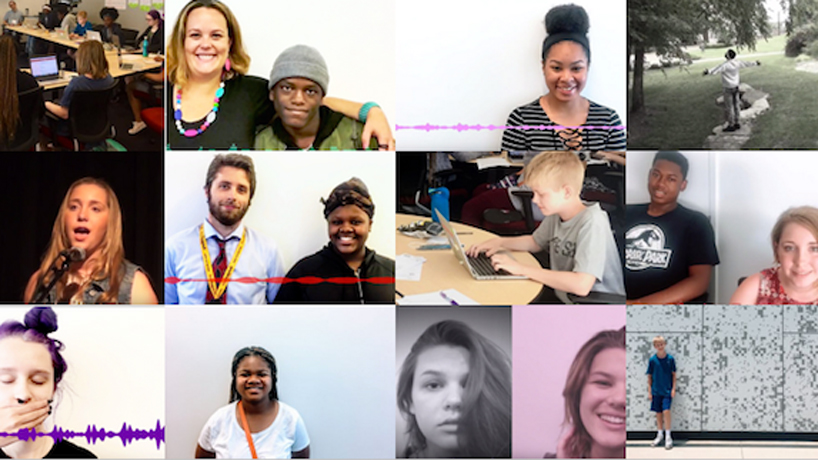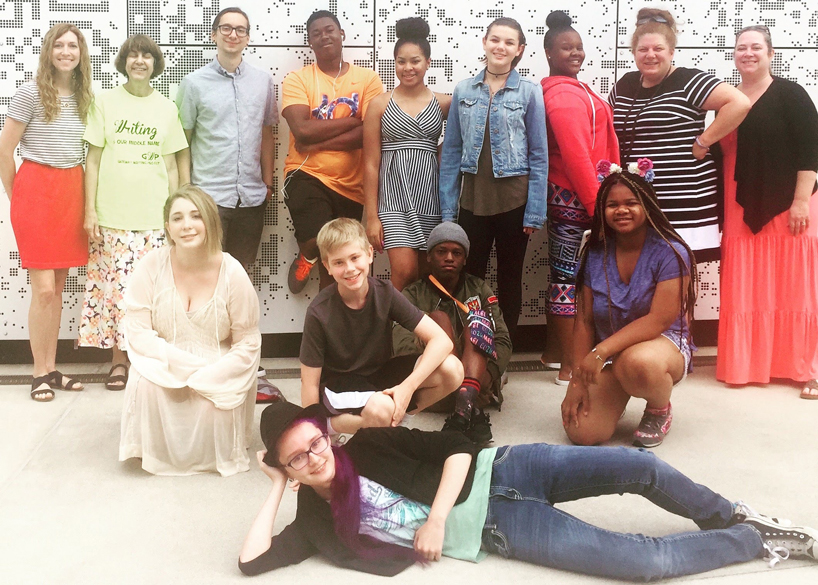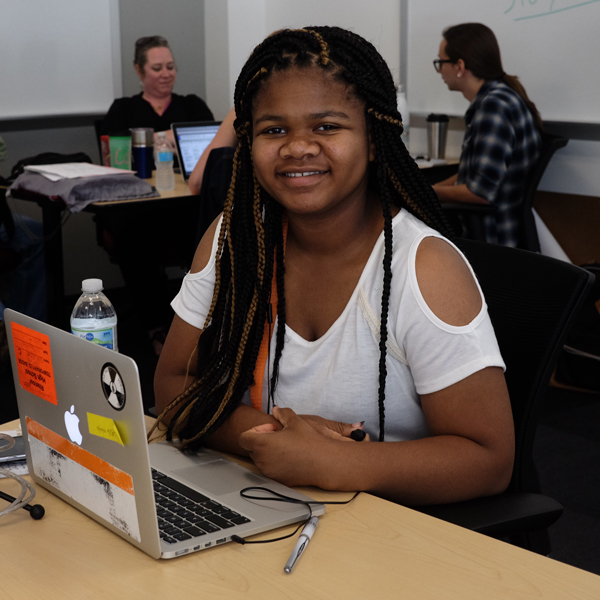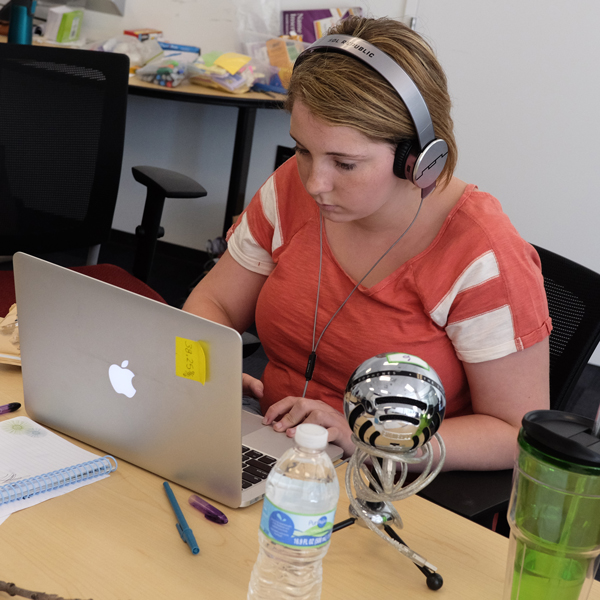
Gateway Writing Project, housed in the College of Education at UMSL, hosted OneCity Stories: a St. Louis Youth Writing Program from June 12 to 30. The immersive summer institute was based out of UMSL at Grand Center and brought together high school students from across the St. Louis area to explore the ways in which writing connects multiple forms of media. (Image courtesy of OneCity Stories)
“Do you think writing is power?”
The question, posed one June afternoon inside a classroom at the University of Missouri–St. Louis at Grand Center, drew an immediate response.
“Definitely,” Edwardsville High School student Sydney Hershberger said. “Writing is used in a lot of ways to create change. Sometimes in good ways. Sometimes in bad.”
Indigo Thompson, a student from Metro Academic and Classical High School, also chimed in.
“I believe words are really powerful,” she said. “You take these words that mean nothing and you can add to them. It’s the way they’re brought together that makes them what they are.”

OneCity Stories program coordinators, instructors and students include (back row from left) Diana Hammond, Cathy Griner, William Morris, Johnathan Baker, Cierra Cross, Cindy Combs, Janylaa Owens, Jane Bannester and Katie O’Daniels; (middle row from left) Sydney Hershberger, Locke Meyer, Saidi Muya and Indigo Thompson; and Ray Reichert. (Photo courtesy of OneCity Stories)
Hershberger and Thompson are just two of several St. Louis-area youth who had the chance to ponder such questions this summer – and to explore the power of not just any words or writing, but their own.
Their opportunity? OneCity Stories, a new youth writing program so impressive that it became one of only 10 educational initiatives in the nation to win a $20,000 2017 LRNG Innovators Challenge Grant.
Sponsored by the Gateway Writing Project at the University of Missouri–St. Louis, OneCity Stories is more than a summer camp. It’s an exploratory, immersive multimedia experience that allows high school students to delve into the issues that matter most to them while also learning about technology and writing-related career opportunities that could enhance their futures.
Aimed at breaking down divisions and obstacles to learning at every turn, OneCity Stories was purposely designed to be welcoming to all St. Louis-area high school students regardless of where they live or what their families’ financial situations are.
Interested students completed an application process, including the submission of a writing sample, to gain entrance to the program. Funds from the Challenge Grant helped make free transportation, free lunches and scholarship opportunities available to students in need so that all they really had to do to participate was show up ready to learn.
Once they did, a team of educators – including Kirkwood High School teacher Diana Hammond, retired teacher Cathy Griner, Ritenour High School teacher Jane Bannester and UMSL graduate student William Morris – was there to help guide them. Hammond, Griner and Gateway Writing Project co-director Katie O’Daniels served as program coordinators.
From June 12 to 30, the team led the students through a jam-packed schedule full of activities and citywide adventures that turned on a different theme each week.
Week one explored journalism, photojournalism and social media. Week two turned to news broadcasting and radio. Week three zeroed in on film scripting, storyboarding, shooting and editing.

Indigo Thompson on OneCity Stories: “It encourages me to feel like, yes, this is what I need to be doing. They appreciate my writing, and so I know there’s someone else out there that will appreciate it also. And then it just keeps on going.” (Photo by Jami Hirsch)
Throughout the program, experts from St. Louis Public Radio, the St. Louis Post-Dispatch, KDHX, Cinema St. Louis, Urb Arts and the Nine Network of Public Media volunteered their time to teach the high school students valuable skills, give them a peek behind the scenes of professional media operations and, of course, answer their questions.
“Where exactly do you get your stories from?” one student asked during an afternoon’s Q&A with St. Louis Public Radio’s Kameel Stanley and Tim Lloyd, hosts of the St. Louis-based podcast “We Live Here.”
The student’s peers took notes on their MacBooks. One adjusted a microphone being used to record the conversation – because everything happening in and outside of the classroom was fair game for whatever the students wanted to create.
“The fact is stories are everywhere, and people are interesting,” Stanley answered. “You just have to learn how to tune yourself to listen, to be able to navigate how to convey that story.”
Helping the students learn how to do just that was a large part of Morris’ job.
Serving as OneCity Stories’ artist in residence, he used the knowledge he’s gathered from UMSL’s MFA in Creative Writing program to lead the students through workshops aimed at helping them revise and push the limits of their work.
He was particularly impressed by the breadth of opportunity the students were exposed to, as well as the variety of talents they brought to the program.
“Some of the students were practicing poets, others had great journalistic skills,“ he says. “I helped students with slam poetry, short stories, music videos and movie trailers, among other incredible projects.”
Morris added that one of the best parts of the experience was seeing the connections the students were able to make with each other, despite their different backgrounds, because of the writing that was woven through each of their creative endeavors.
“After each workshop, the students were eager to keep working on their writing and improve based on the feedback they’d been given,” he said. “This is something I value highly as a writer: a community of other writers who can help you further expand and develop your work.”

Sydney Hershberger on OneCity Stories: “It’s a lot different than I thought it would be. I thought it was going to be like an extra class of school, but it’s much more than that. It’s not like a classroom so much as it is learning and then getting to put what we know to the test right away.” (Photo by Jami Hirsch)
That same sense of community was something Hershberger said she picked up on too – right away.
“In previous writing groups I’ve tried I didn’t notice it,” she said, “but in this one, yes. We all share ideas. A lot of them are just ideas about the world in general. You get to know a lot about a person that way.”
As for Thompson, she said she was also getting to know more about herself, about the strength of her own words.
“I wrote a poem that I actually spoke – here, last Friday,” she said. “I believe that was one of the first things that I’ve ever written that was powerful. It was powerful because it came from my heart. It didn’t just come from an idea out of my head. And I made sure the word choice was correct. I made sure it got the opinion across that I wanted.”
Thompson went on to share one final thought about why the writing teenagers get to do in programs like OneCity Stories is so important.
“People need to know that teenagers, if we’re writing and writing freely, it’s obviously something that is personal or something that we’ve thought of that is creative, and we’re trying to verbalize something toward you,” she offered. “If we’re freely writing, it’s probably something you should pay attention to.”
To learn more about OneCity Stories, the student participants’ work, or the ways in which it will continue beyond the three-week summer institute, follow along on Facebook, Twitter and Instagram.















